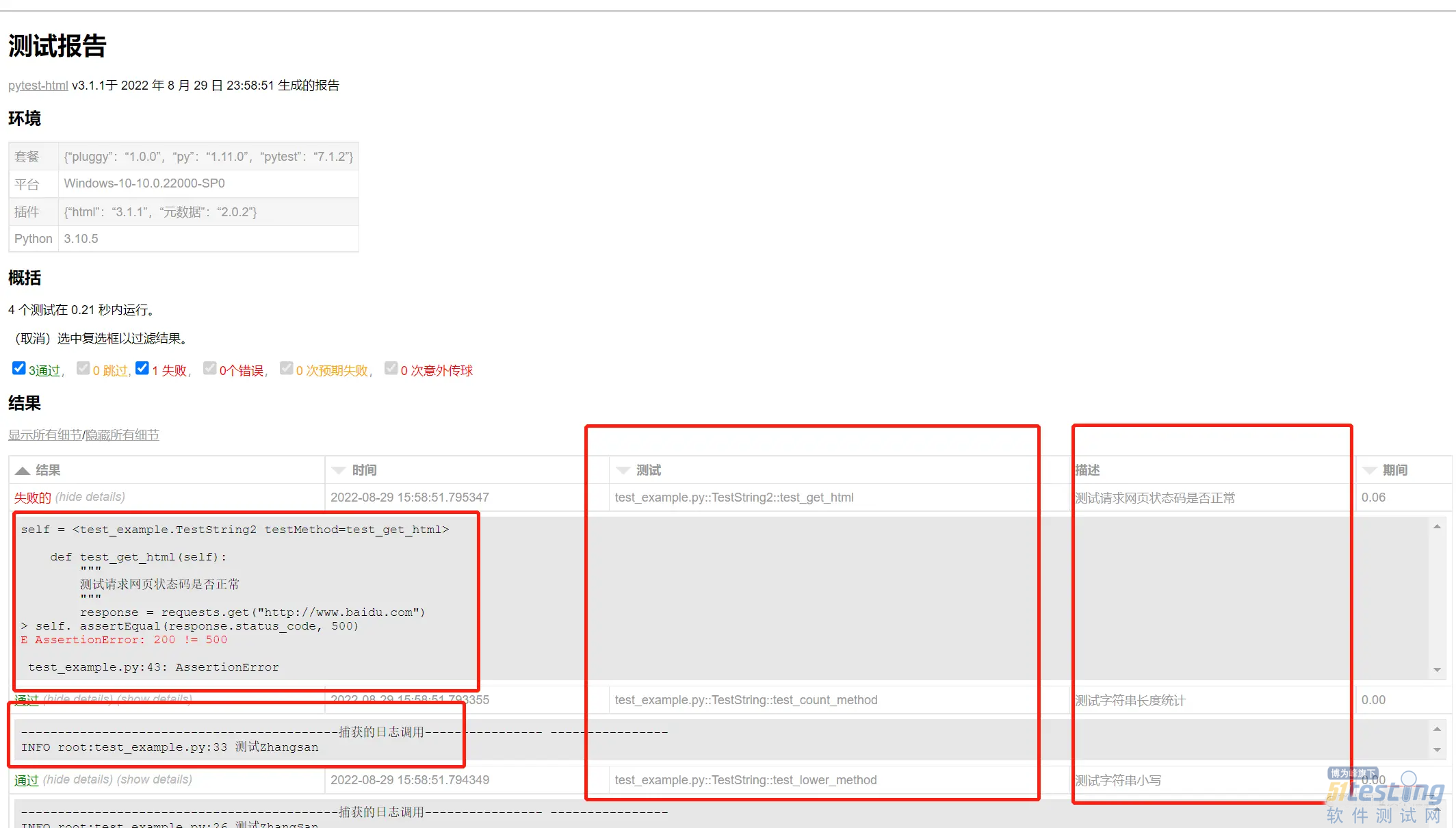背景
考虑到日常使用Python自带的UnitTest,所以先从官方文档下手,了解到有相关的TestTextRunner:https://docs.python.org/zh-cn/3/library/unittest.html?highlight=unittest#unittest.TextTestRunner。
自带的TextTestRunner每次能把测试结果输出到流中的测试运行器,可以简单根据verbosity调整每次测试结果输出的信息,但是都太基础了,如果我想在测试过程中打印一些请求参数或者docstring,看了一下UnitTest内置的方法,实现过程可能会比较繁琐。
然后在网上找了一下轮子工具、html-testrunner、beautifulreport,这些工具生成的网页css、js都是使用公网的CDN,由于内网环境,不适合。
模块安装
pip install pytest
pip install pytest-html
方案设计
pytest.ini
首先定义pytest.ini(pytest的基础配置文件,和测试文件在同一目录,使用pytest命令时会先读取该文件):
[pytest]
log_cli = True
log_cli_level = INFO
备注:开启日志消息打印,设置日志记录捕获的最低消息级别为INFO。
conftest.py
设置conftest.py(没有自己创建,同样是和测试文件同个目录下,用于pytest-html生成测试报告的配置文件):
# --*-- coding: utf-8 --*--
from datetime import datetime
from py.xml import html
import pytest
def pytest_html_report_title(report):
report.title = "测试报告"
def pytest_html_results_table_header(cells):
cells.insert(2, html.th("Description"))
cells.insert(1, html.th("Time", class_="sortable time", col="time"))
cells.pop()
def pytest_html_results_table_row(report, cells):
cells.insert(2, html.td(report.description))
def pytest_html_results_table_row(report, cells):
cells.insert(2, html.td(report.description))
cells.insert(1, html.td(datetime.utcnow(), class_="col-time"))
cells.pop()
@pytest.hookimpl(hookwrapper=True)
def pytest_runtest_makereport(item, call):
outcome = yield
report = outcome.get_result()
report.description = str(item.function.__doc__)
通过设置钩子函数分别修改测试报告的列,添加描述列、测试用例耗时时间列、删除链接列,我这里是直接参考官方文档中给出的示例:https://pytest-html.readthedocs.io/en/latest/user_guide.html#creating-a-self-contained-report,有兴趣的可以研究一下。
测试用例
根据Pytest的官方文档,Pytest同样是支持UnitTest的功能,所以可以在原有的基础上直接运行Pytest:
# -*- coding: utf-8 -*-
# @Author: linshukai
# @Desc: pytestc测试用例
# @Date: 20220827
import unittest
import pytest
import logging
import requests
class TestString(unittest.TestCase):
def test_upper_method(self):
"""
测试字符串大写
"""
self.assertEqual("linshukai".upper(), "LINSHUKAI")
logging.info("测试linshukai")
def test_lower_method(self):
"""
测试字符串小写
"""
self.assertEqual( "ZhangSan".lower(), "zhangsan")
logging.info("测试ZhangSan")
def test_count_method(self):
"""
测试字符串长度统计
"""
self.assertEqual( len("zhangsan"), 8)
logging.info("测试Zhangsan")
class TestString2(unittest.TestCase):
def test_get_html(self):
"""
测试请求网页状态码是否正常
"""
response = requests.get("http://www.baidu.com")
self.assertEqual(response.status_code, 500)
if __name__ == "__main__":
pytest.main(["pytest_example.py", "--html=report.html", "--self-contained-html"])
备注:简单写了几个测试用例,需要特别说明的是可以通过pytest.main()方法,直接在Python代码中调用Pytest,所以我每次只需要执行这个脚本就行,当然也可以选择在命令行界面通过Pytest命令调用指定测试文件执行指定测试用例。
另外一个地方需要注意的是--self-contained-html这个参数主要是针对pytest-html模块,由于默认pytest-html中生成测试报告的网页和CSS文件都是分开来存储的,如果想直接将css文件合并到html中,这样分享测试报告的时候也更加方便,所以只需要加入这个参数即可--self-contained-html。
预期效果
预期会出现的问题
Pytest中使用requests,抛出错误,但不影响测试结果,抛出的异常:
Windows fatal exception: code 1073807366
解决方式,降低Pytest为4.6.11版本后,异常就不会抛出,但是pytest-html需要6.0版本上的Pytest,由于不影响测试结果,更加完善的解决方法后续再研究。
本文内容不用于商业目的,如涉及知识产权问题,请权利人联系51Testing小编(021-64471599-8017),我们将立即处理
















